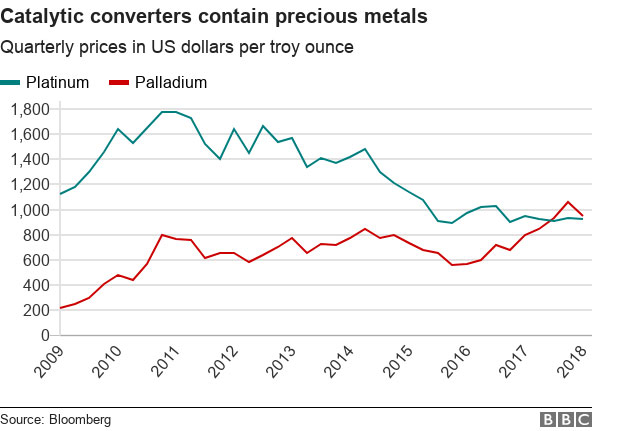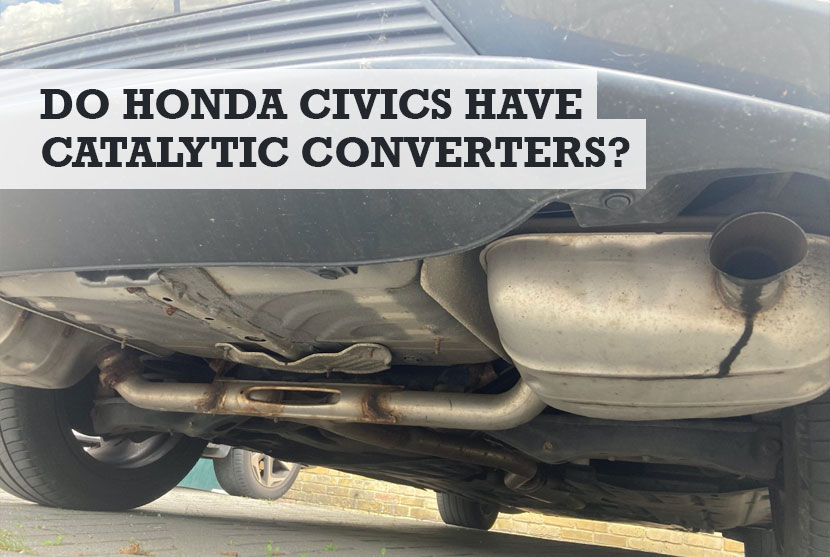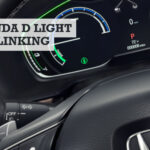Have you ever wondered if your Honda Civic comes with a catalytic converter? Perhaps you want to know where it’s located, or what it even does. This guide I wrote will help clear up any questions you have. But firstly…
Does a Honda Civic have a catalytic converter? Honda Civics do have catalytic converters. Cars manufactured after 1975 in the United States and 1993 in the UK are required by law to have a catalytic converter installed.
The clean air act made this necessary to pass emission tests on most cars, so unless your Civic is the first-generation model in the US, or older than 1993 in the UK, it will come with one pre-installed.
Catalytic converters can be a confusing topic, they’re a part of most vehicles that come as standard, but it’s not common knowledge as to how they work or how long they last. I am going to examine all the details to make sure you understand everything you need to know about this component.
Does a Honda Civic Hybrid have a catalytic converter?
Yes, all hybrid Honda Civics will come with catalytic converters as the petrol / gas elements of the engine still need to adhere to the law regarding emissions. However, purely electric cars do not have catalytic converters.
Will my Honda Civic already have a catalytic converter?
The vast majority of Honda Civics will have a catalytic converter due to the laws passed as I already mentioned. The only case where this could be an issue is with a first-generation model Honda Civic. These were released in 1972, but the clean air act wasn’t in full swing until 1975.
In the 1950s car emissions were becoming a huge public health problem, and combustion-based engines were significantly more powerful, but this meant a massive uptick in the emissions produced by the new cars.
The reason the 1972 model doesn’t have a converter is that its engine can use both leaded and unleaded fuel. Leaded fuel contains lead, this is a big problem because lead can cause massive damage to the converter.
Then in Europe in 1993 it became a legal requirement for all new cars to be manufactured with catalytic converters – you can read more about this on the RAC website.
Handy Hint: Find out whether your Civic has a timing chain or a timing belt with this easy to understand guide.
First-gen problems
The first-generation Civic is the only case where you would have a problem, but every other Civic generation after has a catalytic converter installed at production in the United States.
For most Honda Civic owners, their car will come with one already fitted. But a Honda Civic without a converter could be a problem depending upon where you are.
For example, in the United States, a car that fails an emissions test can’t be registered, which means you can’t be licensed to drive it.
However, this can also depend upon which state you live in the US, as some states have waivers if you can prove you’ve spent a certain amount in repairs. Some states in the US also offer financial assistance.
Where is the catalytic converter located on a Civic?
Where the catalytic converter is located on your Honda Civic will vary depending upon the model year and how old your car is. The newer the make the closer the catalytic converter will be to the engine. It’s typically placed around the tailpipe and intake manifolds though.
The 2008 series of Honda Civics and all models onwards have the converter located in the engine bay, often bolted onto the engine. This is to make it much harder to steal.
Catalytic converters need heat to work properly. The heat from the engine speeds up any chemical processes that this component needs to work at its best. Previous models needed some distance between the muffler, plus a heat shield to ensure that the converter doesn’t end up damaged.
Usually, your converter will be bolted or welded on. You can look for them yourself by tracing the exhaust system, as it’s one of the components pieces of most modern cars.
Honda Civic catalytic converter thefts
Catalytic converter theft is a big problem, no matter if you’re from the US, UK, Europe, or across the world. Manufacturers have attempted to make theft of converters more difficult because they can cost their owners a lot to replace (in the range of hundreds of dollars/pounds/euros).
What are manufacturers doing to prevent theft?
Generally speaking, they are bolting or welding the converters to the engine or making it so that it’s much more difficult to access the component. It can be covered by plates, or be located fairly deeply in the engine box, so you have to take out parts just to access it.
Honda is no exception, they are putting the catalytic converters deeper within the engine box, as well as bolting them to the engine itself. On a honda civic 1.5, it’s located very close to the engine, it’s difficult to access, and would require removal of a plate at the bottom of the chassis.
Handy Hint: Do you leave the Honda ECON button on all the time? Here’s reasons why you might want to reconsider.
Why do catalytic converters get stolen?
As mentioned, catalytic converters need three precious metals to perform their function. These metals are rhodium, platinum, and palladium. These metals are worth a decent amount of money to scrappers.
On older cars they are easier to access, making them a tempting target for thieves – as you can see from this graph on the BBC website.

What is a catalytic converter?
A catalytic converter is designed to prevent or reduce harmful emissions that come out of your exhaust. The “catalysts” are chemicals that cause chemical reactions, and they convert harmful, toxic gases (hydrocarbons, carbon monoxide, and nitrogen oxides) into carbon dioxide and water vapor.
Handy Hint: Here’s how many gallons of fuel you can get into your Honda Civic – good to know before a long journey!
A catalytic converter is made up of tiny little cells that act as a matrix, these cells also contain metals like rhodium, palladium, and platinum. These metals heat up and cause a chemical reaction that breaks down the toxic emissions.
Sometimes catalytic converters are called “cats” for short.
How long does the catalytic converter last?
Your catalytic converter can last between ten years, or it can last around 110,000 to 160,000 kilometers (70,000 to 100,000 miles). Generally speaking, it’s a component that’s built to last a long time, as it needs precious metals to replace and it’s not too profitable for manufacturers to produce them in large quantities.
Your converter will need to be checked regularly though because how you use your vehicle can affect the part’s lifespan. Your converter needs heat to work properly, if your engine isn’t running for long enough to generate enough heat (you’re only using your car for very short journeys) it can cause increased wear and tear.
While your cat converter should last a long time, it’s always a good idea to have it regularly checked. Small faults and damage can be easily repaired. However, replacing the entire component is expensive, not just for the part but the labor cost also.
What are the signs a catalytic converter is broken?
Here are the signs that your converter might be broken or defective:
- A lethargic engine.
- Very dark exhaust emissions.
- A rotten egg smell coming from the exhaust.
- Heat stemming from under the car.
- Sluggish acceleration.
- Exhaust rattling.
There are other signs, but these are the big ones to look out for. Bad exhaust emissions are especially dangerous. Having the windows down on a long journey while having an excess of toxic fumes around you can cause distracting headaches and potentially affect your vision.
What can cause a catalytic converter to break down?
- While catalytic converters need an optimal amount of heat to function, overheating can cause significant component damage.
- Unburned fuel can be a serious problem for converters, if your system is pushing too much fuel into the engine, it can end up being burned by the exhaust causing massive spikes in temperature.
- Exhaust flow disruptions, any disruption in exhaust flow can cause damage to a converter, this is most likely due to carbon build-up.
- Coolant leaks, any chemicals that are in places they shouldn’t, can cause serious damage to a converter – here’s how to fix a water leak.
- Impact damage, going over a bad pothole or any heavy impact to the car can also cause damage to its components, the converter is no exception.
A side note about blockage, it’s not unheard of for converters to unblock themselves, as long as it isn’t too severe.
Conclusion
In conclusion, if you own a Honda Civic, it’s almost guaranteed to have a catalytic converter installed… unless or course yours is old, or the catalytic converter has been stolen.






